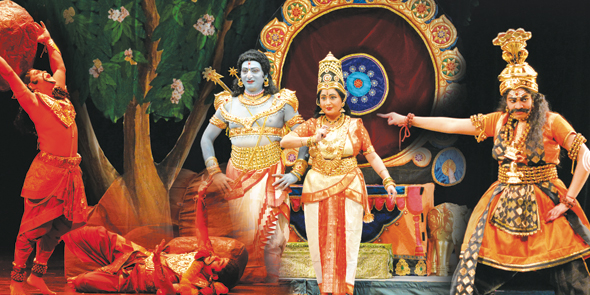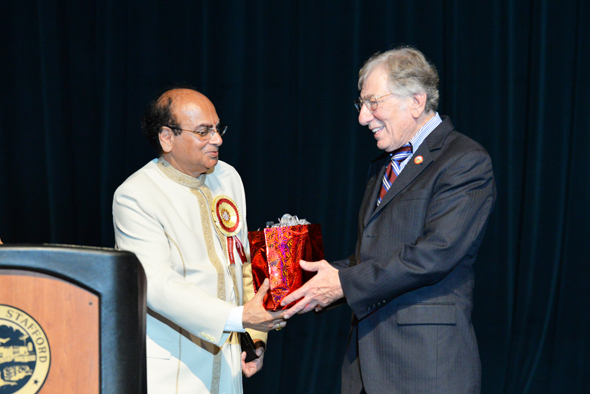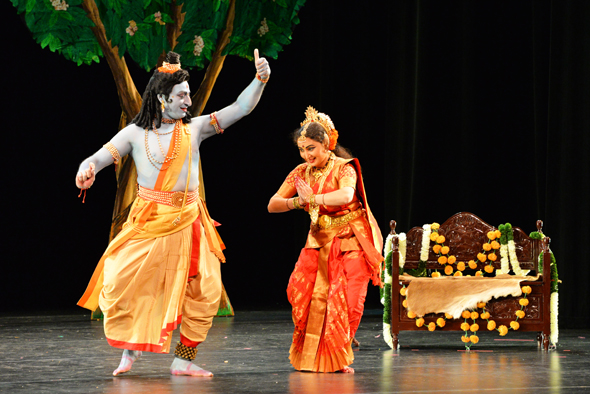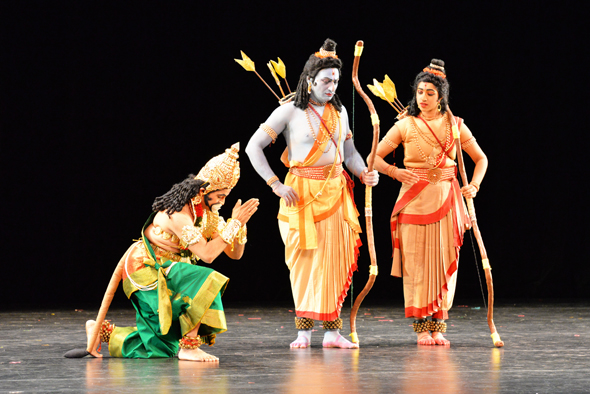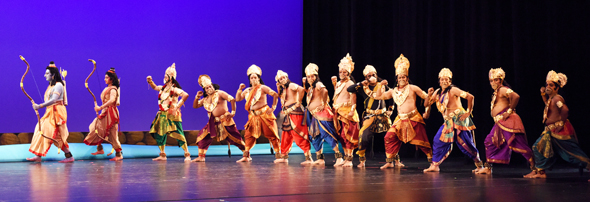A Ram Leela in Kuchipudi Ballet Style with a Blue Avatar Lord Rama
Saved under Arts & Culture, Community, Current Stories
Tags: Baytown, Clear Lake, Cypress, Desi news, Dr. Arun Verma, Greater Houston, Houston, Houston Desi news, India, Indian American community, Indian News, Indians in America, Indo-American News, Katy, NRI, pearland, Shri Sita Ram Foundation, south asia, South India, Sugar Land, Texas, USA
By Jawahar Malhotra
STAFFORD: It did seem odd that the marquee sign at the corner of the Stafford Civic Centre on Cash Road was off and wasn’t flashing all the upcoming evens as it usually does, and in particular the main event – the Ram Leela – scheduled for that evening. Despite the thunderstorm, pouring rain and the gusty winds, the audience kept streaming in to the auditorium lobby, to be welcomed by a giant bronze Ganesh, this past Sunday afternoon at 3:30pm, July 15 and soon the space was packed to capacity.
Then, someone broke the news that the Centre, and most of the area around it stretching into Sugar Land, had lost electricity and Centerpoint Energy was working hard on restoring it. People waited patiently, some sitting on the stairs to the balcony, others even started to sing some bhajans in front of the three religious booths setup to highlight the efforts of the Sri Rama Jaya Niketan, a new non-profit, to establish a new temple in Katy.
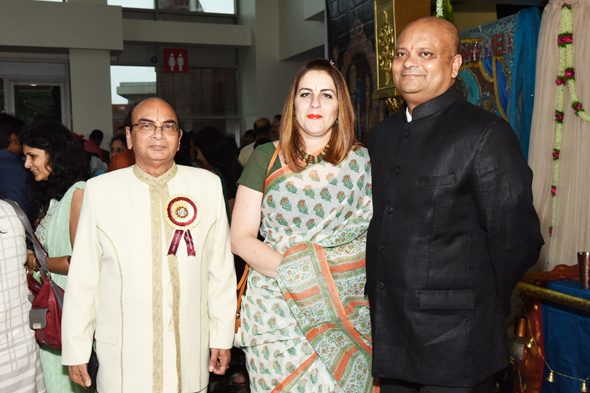
Dr. Arun Verma of the Shri Sita Ram Foundation with the Indian Consul General Anupam Ray and his wife Amit at the Ram Leela program at Stafford Civic Centre on Saturday, July 15
Dr. Arun Verma and his wife Vimmi of the Shri Sita Ram Foundation who had organized the event, along with others from the SRJN and supporting organization Jeeyar Educational Trust USA Houston Chapter had worried looks. The Indian Consul General Anupam Ray and his wife Amit came, mingled for sometime and then left, and many others followed suit as the disruption lingered on. Rumors spread that the emergency generator didn’t work and there were no emergency lights. And then, around 5:15pm – nearly 75 minutes after the event’s scheduled time, the lights suddenly came back on to a collective yell from the crowd which rushed in to their seats.
Nina Magon, the Verma’s daughter wasted no time in welcoming everyone in. “We were just about to postpone the event when the lights came on!” she said, intoning the audience in three rousing “Jai Shri Ram!”s and keeping the formalities abbreviated. Stafford Mayor Leonard Scarcella walked up to the podium to “applaud the Indian community for making this center a place for your events” and admired the patience of those who stayed despite the electricity disruption.
Special tokens of gratitude were handed out to Scarcella, dancer and choreographer Rathna Kumar and tireless volunteer Ravi Shankar Puri. Later, before intermission, all the large donors to building the temple were honored onstage and the inaugural issue of the Katy temple souvenir was unveiled.
The SSRF has been holding the Ram Leela performance for many years, and usually these are in the popular version of the play that is conducted in Northern India at the conclusion of Dusserah, which is a well-known pantomime with Hindi narration. This year, Dusserah is on September 30, but the event organizers decided to fast forward the performance to match the SRJN fundraising efforts. The SSRF will continue with its hugely popular Dusserah and Diwali Mela at Skeeters Stadium in Sugar Land on October 28.
This early Ram Leela was a departure from the traditional play as it was performed as in Kuchipudi dance ballet style with its heel-to-toe steps, and called the Sri Rama Katha Saram. For most Northern Indians in the audience, it was a huge change in depiction, though the story of Lord Rama and all the other characters was essentially the same. One important difference was the depiction of Rama as a blue bodied avatar, so ably and precisely produced and acted out by Vedantam Ragahava, the Executive Director of Vedantam Kalakshetram (based out of the Asthalakshmi Temple) which staged the play, supported by his wife Sharmi Padmaja Vedantam who played Sita.
The play started with an introduction to the period setting and invocations by the Nandi Stuti Dancers and the Bala Bhogam Dancers, with a prelude to the Rama Avatar by dancers Niharika Pakala, Sanjana Kasetti and Sinzita Cheruvu, as well as Aparna Kambhampati, Bhavya Kethireddipalli, Sahiti Rudravajhala and Yuthika Gundamaraju and the Ananda Hela Dancers.
All the other actors – who also were dancers – are Raghava’s students from various schools and universities across this part of Texas and it was obvious that they had rehearsed their lines and moves till it was second nature to them. Many received wild ovations and yells of support from the audience, like Sandhya Muchimilli who played Surpanakha with such glee and abandonment, Huma Morpathi who played the devoted Lakshmana and Murali Lanka who played Hanuman with vigor and poise, jumping out of a tree to make his entrance. Not to be left out is the formidable presence of Ravana played by Aruna Jyothi Nanduri.
Raghava’s Rama had a stage presence that stood out and every movement he made – like resting his hand standing by a tree prop – was a measured portrayal. The attention to detail of every pose, expression and collective episode, like the Sugriva Mattri, showed the ease of the actors with their roles. And that is not to forget the pre-recorded music and narration by singers DVS Sastry and Padma Ramalinga Sastry, which was mostly in Sanskrit with a mix of Telegu, to which the actors and dancers timed their moves.
There were so many positives in the overall play that it would take another column to describe it. But the proof was in the thunderous standing ovation from the audience which brought the hall down. Though many people had left due to the unfortunate late start, sixty percent of the auditorium was still filled to enjoy the spectacle and those who left missed a wonderful experience. For Arun Verma, firm in his dedication to Lord Rama, “in the play I saw devotion and perfection. It is worthy of a true Broadway production.” As they left, many encouraged the ensemble to take the production on a national tour.
A particularly poignant moment was the opening to the program when a group of 4 boys and 10 girls, all less than 11 years-old, all chanted the Hanuman Chalissa in rapid unison, memorized and recited with the fluency and ease of much older people. It was a marvel in itself!

